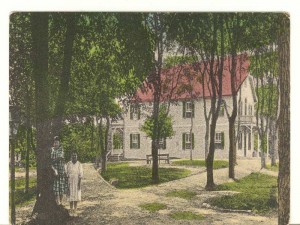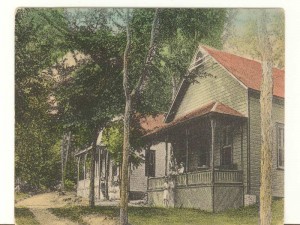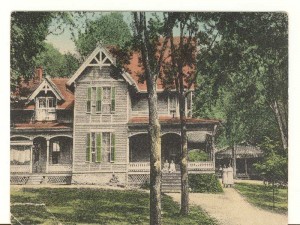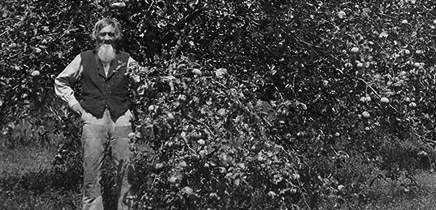The history of Coney Island as a resort begins when Josephine Hassenstaab sold the 31.85-acre island to Lambert Naegele in March, 1884, for $5,200. While Waconia already had several hotels such as the North Star, Lake House, and the Sherman House Hotels, Coney Island Hotel and resort (not formal) became, by far, the most popular of all of Waconia’s hotels and contributed to Waconia being a favorite summer resort town.
Lambert Naegele developed the island and was the one to name it “Coney Island of the West”. Where this name originated is unclear. Some claim it is named after the Coney Island Entertainment center on the East Coast. Others, that it is named for the large numbers of “coneys”, or rabbits, that lived on the island. Finally, one group claims “Coney” is just a shortened version of Waconia. There is not enough evidence to support one of these claims over the others.
As part of his initial development, Lambert Naegele divided the island into lots, parks, and streets. He named the streets for famous German authors, such as Goethe, Uhland, Schiller and Lessing. He sold plots he laid out to private owners. Naegele also built a large hotel and private cabins, for either rent or sale. In 1886, a new hotel, later known as the boarding house or dormitory, several more cottages, and a boathouse were added. Naegele suffered poor health while starting his resort, forcing a move to better climates in Montana. In 1889, Naegele sold the hotel complex to Reinhold Zeglin, whose family had taken possession of it at the end of the summer season in August 1888.
Zeglin, a German immigrant like Naegele, made plans for a third hotel, designed to sleep one to two hundred guests. With this added space, numbers of hotel guests began to rise. Part of the draw was Zeglin’s addition of a bowling alley and Sunday concerts to amuse his guests. He also added a laundry, dining room, kitchen, and pavilion to his new hotel. In 1895, Zeglin rented Coney Island Hotel and resort to Emil Krueger of Stillwater but he returned to run his island resort in 1896.
The resort’s reputation was growing. Guests came to stay for periods of weeks or months, with many remaining all summer. Some, like Emile Amblard, “Duke of Clearwater Lake”, stayed permanently. Amblard, a French winemaker and businessman, came to visit and loved the island and town so well that he remained the rest of his days. Guests came from nearby Minneapolis/St. Paul and elsewhere in Minnesota. Others came from New York, Ohio and Illinois, or as far away as Europe and South Africa. There were even some famous guests. The guest register from June 20, 1896 shows silver-screen movie star Sarah Bernhardt staying at the hotel. Between 1903 and 1905, the University of Minnesota Gohper’s held pre-season practices on the island’s football field.
Zeglin’s sons took over the resort in 1909. However, business was beginning to slow by 1919 due to outside factors. The car allowed people to travel further with more ease than trains. With this new flexibility, vacationers traveled further and longer, spending summers in other states rather than locally. In 1927, the name was changed from Coney to Paradise Island, to encourage more guest visits. The name would not last. The Zeglin family sold the resort in 1939 to Frank Dvorak.
Frank “Shorty” Dvorak bought land on the island in 1939, soon adding a dance hall, a restaurant, and more cabins. The island became a weekend dinner/dancing spot, rather than a resort. Dvorak sold the complex to the Day Camp Company in 1959. The island deteriorated due to lack of proper maintenance, and their contract defaulted back to Dvorak in 1960. He was the last owner who operated the island as a place for entertainment.
Since 1960, the island has had many private owners. Vandalism and time took their toll on the island. In 1975, efforts were started to rehabilitate the island, lead by the Waconia Bicentennial Committee’s Island Committee. In 1977, a study was conducted by Dunwiddie Architects on the island and its possible uses. A year later, Coney Island of the West was placed on the National Register of Historic Places. In the twenty-first century, there have been many ideas on restoring the island, but so far, high costs have prevented development. The current owner has plans to turn the island into a public park.
Turning Point: Coney Island helps turn the city of Waconia into a summer tourist spot, especially during the peak years between 1890 and 1910.
Chronology:
- March 1884: Josephine Hassenstaab sells the 31.85-acre island to Lambert Naegele for $5,200. He builds a hotel and roads soon after, and divides the rest into plots to sell to private owners.
- 1886: Naegele adds a new hotel building, later known as the boarding house or dormitory, several more cottages, and a boathouse to the island.
- August 1888: the Reinhold Zeglin family moves onto Coney Island to take over the resort.
- 1889: Naegele officially sells the hotel complex to Reinhold Zeglin.
- 1895: Zeglin rents Coney Island Resort to Emil Krueger of Stillwater. The Zeglin family moves to a home on the mainland.
- 1896: Reinhold Zeglin resumes control of Coney Island Resort.
- 1899: The Zeglin moves back into their home on the island, in the original hotel building.
- June 20, 1896: The Coney Island Hotel guest register shows silver-screen movie star Sarah Bernhardt as a guest.
- 1903-1905: The Minnesota Gopher’s football team uses the Island’s football field for pre-season practices.
- 1909: The sons of Reinhold Zeglin take over running the hotel and resort.
- 1927: The Zeglins change the name of the Island to “Paradise Island,” though the name does not stick.
- 1939: The Zeglins sell Coney Island Hotel and resort.
- 1940: Frank “Shorty” Dvorak begins additions on the island, soon adding a dance hall, restaurant, and more cabins. The island becomes a weekend dinner/dancing spot.
- 1959: Frank Dvorak sells the island to the Day Camp Company; they let the island and buildings deteriorate and the contract defaults back to Dvorak in 1960.
- 1975: The Waconia Bicentennial Committee creates the Island Committee in an attempt to revitalize the island.
- 1977: A study is conducted by Dunwiddie Architects on the island and its possible uses.
- 1978: Coney Island of the West is placed on the National Register of Historic Places.



BIBLIOGRAPHY
“Began Building Largest Hotel on Coney Island of the West”. Weekly Valley Herald, September 27, 1888.
“Coney Island Nominated for National Registry”. Waconia Patriot, January 29, 1976.
“Coney Island Storm Swept”. Young America Eagle, August 26, 1904.
“Coney Island of the West Has Been Purchased by Reinhold Zeglin”. Weekly Valley Herald, August 16, 1888.
“Coney Island: Waconia is Devastated”. Waconia Patriot, August 26, 1904.
“Coney Island Will be Beautified”. Weekly Valley Herald, February 25, 1886.
“Island Sold. Soon to Be “Coney Island””. Weekly Valley Herald, March 13, 1884.
Lahr, Grace. “A History of Events in the Development of Coney Island and Clearwater Lake”. Waconia Patriot, April 17, 1975.
“Put Up a Bowling Alley on Coney Island”. Weekly Valley Herald, May 16, 1889.
“Record Made at Coney Island Hotel”. Waconia Patriot, September 5, 1918.
“The Island Hotels, Crowded to Capacity”. Weekly Valley Herald, July 21, 1898.
“Waconia Cyclone “. Educational program. Carver County Historical Society.
Waconia Heritage Association. Waconia, Paradise of the Northwest: The Lake and Its Island. Dallas: Taylor Publishing Company, 1986.
RELATED RESOURCES
Primary:
Miller Dunwiddie Architects, Inc. “Coney Island of the West”. Research and planning study of Coney Island of the West, Waconia Lake, Carver County, Minnesota : for the city of Waconia. Minneapolis, MN: Miller Dunwiddie Architects, Inc., 1979.
Monasch, Isador. “Coney Island of the West in Clearwater Lake”. Cartographic map. Minneapolis, MN:1870.
[Secondary]
Holcombe, Maj. R.I., editor. Compendium of History and Biography of Carver and Hennepin Counties, Minnesota. Henry Taylor and Company: Chicago, 1915.
Lofstrom, Ted and Lynne VanBrocklin Spaeth. Carver County: A Guide to Its Historic and Prehistoric Places. St. Paul: Minnesota Historical Society Press, 1978.
Tremblay, Ruth and Lois Schulstad. Images of America: Carver County. Arcadia Publishing: Charleston, South Carolina, 2011.
[Web]
Explore Our City- History of Waconia. City of Waconia website. Accessed March 15, 2013. http://www.waconia.org/index.asp?Type=B_BASIC&SEC={1490747B-B025-4B8F-97F5-553A10427D7C}
Images/Audio/Video
AV-80-1488. Photograph Collection, Carver County Historical Society, Waconia. Postcard “Main Building of Coney Island”Northwestern Importing Co. [Description]: This shows the original hotel building, which also sometimes served as a private residence to the hotel and resort owners. Rights held by the CCHS.
AV-80-1490. Photograph Collection, Carver County Historical Society, Waconia. Postcard “Cottages at Coney Island Hotel”Northwestern Importing Co. [Description]: This image shows some of the many cottages built as part of the resort, to be rented out by guests. Rights held by the CCHS.
AV-80-1492. Photograph Collection, Carver County Historical Society, Waconia. Postcard “Dormitory at Coney Island Hotel” Northwestern Importing Co. [Description]: This image shows the second hotel building, which later became the boarding house, or dormitory, for hotel staff. Rights held by the CCHS.
“This article used with the permission of MNopedia, operated by the Minnesota Historical Society, under a Creative Commons License. No changes have been made to the article’s content.”


